Camille Fine, USA TODAY
Updated Fri, October 6, 2023

Scientists and volunteers at the Field Museum in Chicago collected nearly 1,000 birds Thursday, Oct. 5. The museum said it was the most amount of bird deaths recorded in their 40 years of data collection.
An unseen amount of bird deaths from window collisions occurred this week in Chicago, according to the Field Museum.
These preventable tragedies occur every year, especially during fall and spring migration, but this incident was noticeably worse. Nearly 1,000 birds died after striking the windows at McCormick Place convention center Thursday, “the most Field collecting efforts have documented in the past 40 years,” a post by the museum said.
The incident has set Chicago’s birding community “abuzz,” reported WTTW, a PBS member television station in Chicago.
According to WWTW, migrating birds were passing over some points of the city at a high-intensity rate of 100,000 that day amid adverse flying conditions. Both factors led to an overwhelming number of birds toward Chicago’s Lake Michigan beachfront along their harrowing journey.
Swarms of birds are flying over the US: Explore BirdCast's new migration tool to help you view them.
In addition to higher incidences of bird collisions, recent evidence has pin-pointed climate change’s impact on birds. Birds in both North and South America are getting smaller as the planet warms, and the smallest-bodied species are changing the fastest, according to previous USA TODAY reporting.
According to the Field Museum, smaller bodies hold on to less heat and larger bodies hold on to more, which helps animals stay a comfortable temperature in different environments. Meanwhile, the birds’ wingspans may have increased so the birds are still able to make their long migrations, even with smaller bodies to produce the energy needed for flight, the Field Museum said.
Data from the Field Museum — collected by a team of scientists and volunteers who search for birds that collide into the center’s windows every day during the migration seasons — has been used in studies to make the case for more protections to make collisions less frequent to help vulnerable birds.
More: New 'hybrid' hummingbird with unusual glittering gold feathers puzzles scientists
Here's what to do to help prevent bird deaths
According to Audubon Great Lakes, collisions with human-made structures are a leading cause of bird deaths in the United States, causing up to 1 billion bird deaths each year in North America. Evidence shows "the total number of birds in the sky on a given night and the direction of the wind both play a role in mortality, but the biggest determining factor was light," Field Museum said.
"It doesn't have to be this way," Audubon Magazine writes. "Though we might not be able to reverse human development, we can be proactive about preventing bird deaths that results from our man-made obstacles."
Groups including Audubon and BirdCast provide the following tips:
Make your windows obvious to avoid confusing birds.
Do not use landscape lighting to light up trees or gardens where birds may be resting.
Close blinds at night to reduce the amount of light being emitted from windows
Advocate for bird-safe building standards and show up to city meetings.
For more specific details on where to start in preventing bird collisions, visit Audubon Great Lakes' website.
This article originally appeared on USA TODAY: How to prevent bird window collisions during migration as deaths spike
Hundreds of migrating birds die after crashing into Chicago buildings
Mike Bedigan
Fri, October 6, 2023
Ornithology enthusiasts in Chicago were left stunned by a “major bird collision” in the city, which has left hundreds of the animals dead.
The incident which occurred earlier this week comes amid a major migration in the area, with adverse weather, glass and high-intensity migration thought to be among the causes.
The Chicago Bird Collision Monitors reported that its volunteers had collected “close to 300 injured birds”, with many more dead, on Thursday alone.
The group’s volunteers work to protect and recover migratory birds killed and injured in the downtown Chicago area each year during spring and autumn migrations.
PhD candidate Taylor Hains, who works at the Chicago Field Museum and assists with bird collection told WTTV News that birds were “still colliding” with windows at the McCormick Place building as rescue operations continued.
The Independent understands that the total number of birds collected on Thursday eventually totalled nearly 900.
David Willard is a retired bird division collections manager at the Chicago Field Museum, where his duties included administering, preserving and cataloguing the museum’s collection of 500,000 bird specimens as well as searching for bird strikes as part of migration research.
He told the Associated Press that the scenes outside McCormick Place was like “a carpet of dead birds at the windows”.
“A normal night would be zero to 15 (dead) birds. It was just kind of a shocking outlier to what we’ve experienced,” Mr Willard said.
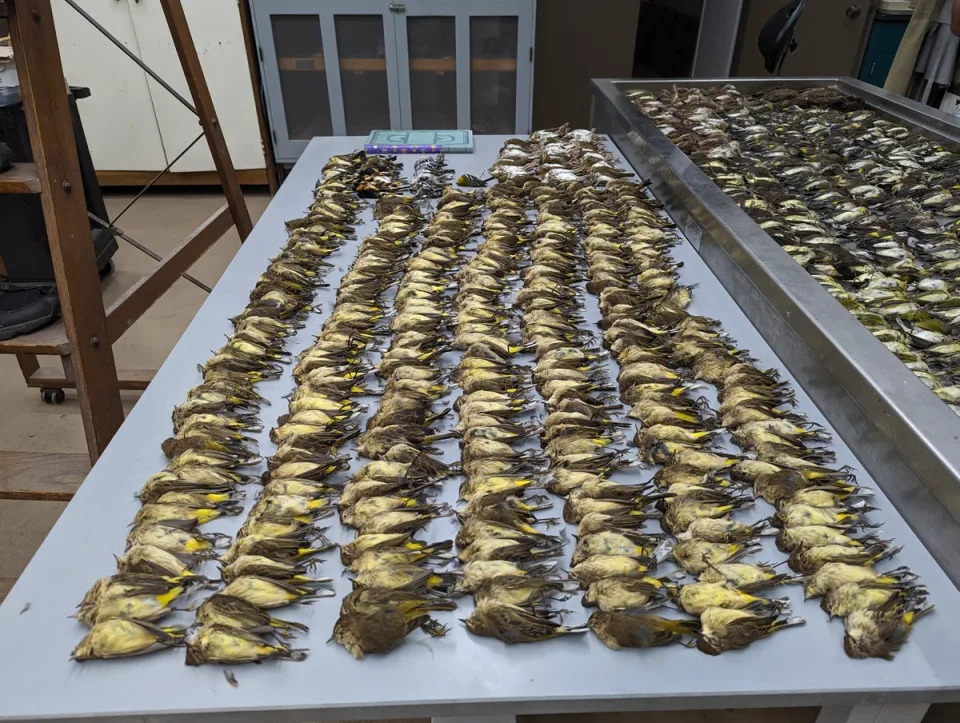
Dead birds in Chicago following a ‘major bird collision’ event (Taylor Hains)
“In 40 years of keeping track of what’s happening at McCormick, we’ve never seen anything remotely on that scale.”
A post from BirdCast, an organisation which provides real-time predictions of bird migrations, read: “Our colleagues and friends in the Chicago, Illinois area have sad news about a major bird collision event that occurred last night and this morning, 4-5 October 2023.
“Reports from the area indicate that large numbers of birds died in collisions while major migration was occurring in the area.
“Although details are still emerging, this event appears to be a combination of high-intensity migration, adverse weather conditions for flying, and light and glass – a mix we know too well can be deadly.”
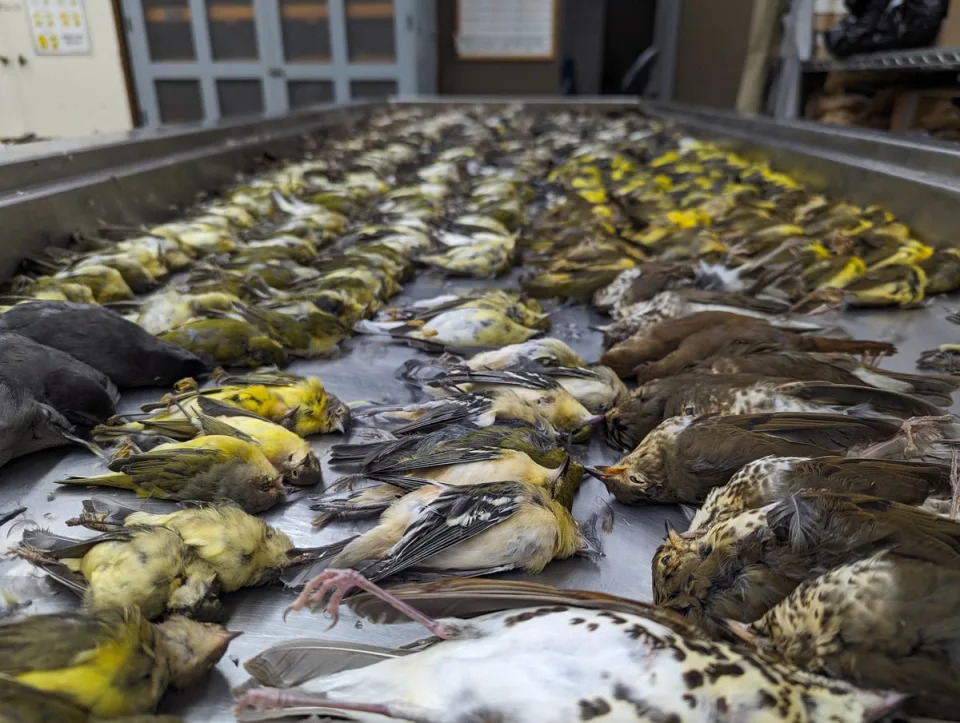
(Taylor Hains)
The organisation also urged “all businesses, building owners and private residences, as well as operators of any illuminated structures, to heed lights-out warnings for non-essential lights to be turned off during the migration season.”
The American Bird Conservancy estimates 1 billion birds a year die from colliding with glass, with window strikes known to be an issue in almost every major US city.
Birds do not see clear or reflective glass and do not understand it is a lethal barrier. When they see plants or bushes through windows or reflected in them, they head for them, killing themselves in the process.
Birds that migrate at night, like sparrows and warblers, rely on the stars to navigate. Bright lights from buildings both attract and confuse them, leading to window strikes or birds flying around the lights until they die from exhaustion — a phenomenon known as fatal light attraction
Nearly 1,000 migrating songbirds perish after crashing into windows at Chicago exhibition hall
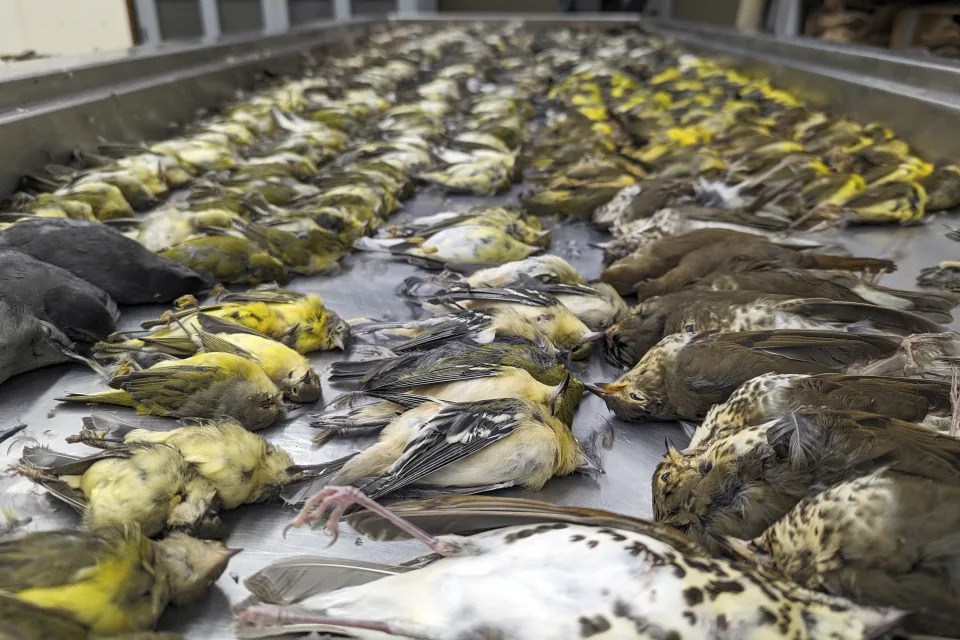
In this image provided by the Chicago Field Museum, the bodies of migrating birds are displayed, Thursday, Oct. 5, 2023, at the Chicago Field Museum, in Chicago. The birds were killed when they flew into the windows of the McCormick Place Lakeside Center, a Chicago exhibition hall, the night of Oct. 4-5. According to the Chicago Audubon Society, nearly 1,000 birds migrating south during the night grew confused by the exhibition center's lights and collided with the building.

In this image provided by the Chicago Field Museum, workers at the Chicago Field Museum inspect the bodies of migrating birds, Thursday, Oct. 5, 2023, in Chicago, that were killed when they flew into the windows of the McCormick Place Lakeside Center, a Chicago exhibition hall, the night of Oct. 4-5, 2023. According to the Chicago Audubon Society, nearly 1,000 birds migrating south during the night grew confused by the exhibition center's lights and collided with the building

In this image provided by the Chicago Field Museum, the bodies of migrating birds are displayed, Thursday, Oct. 5, 2023, at the Chicago Field Museum, in Chicago. The birds were killed when they flew into the windows of the McCormick Place Lakeside Center, a Chicago exhibition hall, the night of Oct. 4-5. According to the Chicago Audubon Society, nearly 1,000 birds migrating south during the night grew confused by the exhibition center's lights and collided with the building.
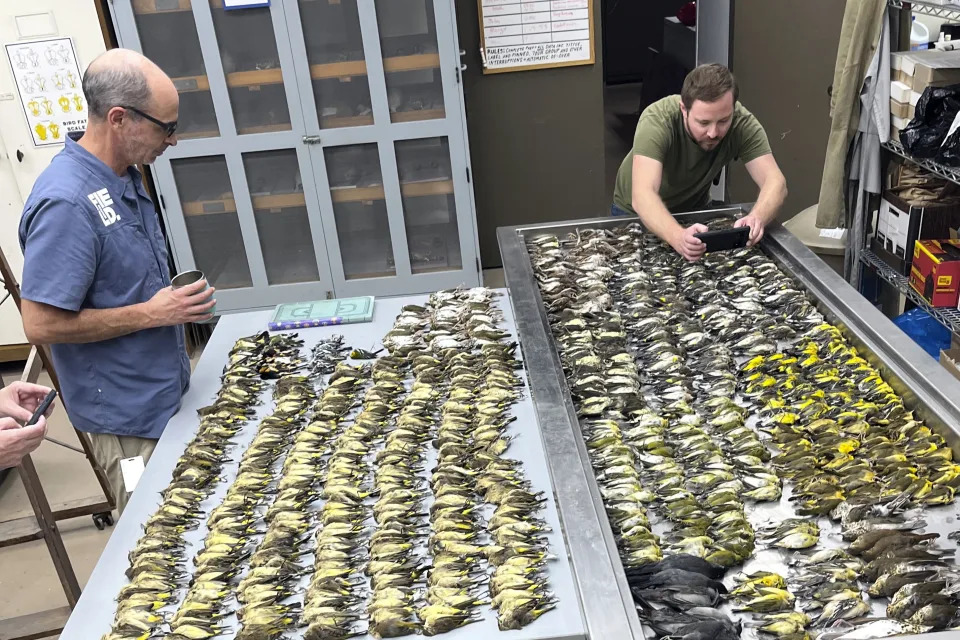
In this image provided by the Chicago Field Museum, workers at the Chicago Field Museum inspect the bodies of migrating birds, Thursday, Oct. 5, 2023, in Chicago, that were killed when they flew into the windows of the McCormick Place Lakeside Center, a Chicago exhibition hall, the night of Oct. 4-5, 2023. According to the Chicago Audubon Society, nearly 1,000 birds migrating south during the night grew confused by the exhibition center's lights and collided with the building.
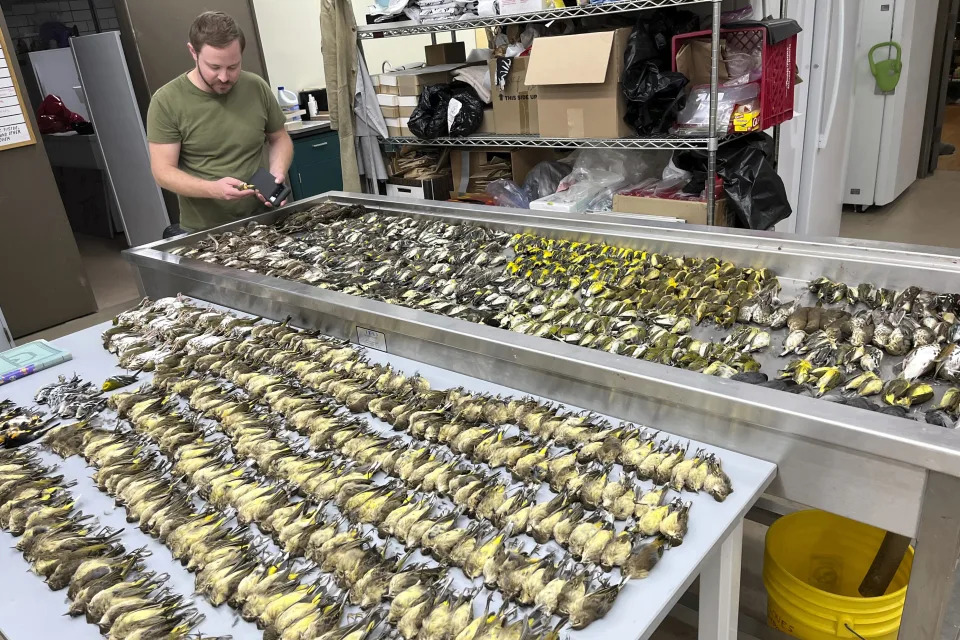
In this image provided by the Chicago Field Museum, workers at the Chicago Field Museum inspect the bodies of migrating birds, Thursday, Oct. 5, 2023, in Chicago, that were killed when they flew into the windows of the McCormick Place Lakeside Center, a Chicago exhibition hall, the night of Oct. 4-5, 2023. According to the Chicago Audubon Society, nearly 1,000 birds migrating south during the night grew confused by the exhibition center's lights and collided with the building.
(Lauren Nassef/Chicago Field Museum via AP)
TODD RICHMOND
Updated Fri, October 6, 2023
David Willard has been checking the grounds of Chicago's lakefront exhibition center for dead birds for 40 years. On Thursday morning he found something horrible: Hundreds of dead songbirds, so thick they looked like a carpet.
Nearly 1,000 songbirds perished during the night after crashing into the McCormick Place Lakeside Center 's windows, the result, according to avian experts, of a deadly confluence of prime migration conditions, rain and the low-slung exhibition hall's lights and window-lined walls.
“It was just like a carpet of dead birds at the windows there,” said Willard, a retired bird division collections manager at the Chicago Field Museum, where his duties included administering, preserving and cataloging the museum's collection of 500,000 bird specimens as well as searching for bird strikes as part of migration research.
“A normal night would be zero to 15 (dead) birds. It was just kind of a shocking outlier to what we've experienced," Willard said. "In 40 years of keeping track of what's happening at McCormick, we've never seen anything remotely on that scale."
Researchers estimate hundreds of millions of birds die in window strikes in the United States each year. Scientists with the Smithsonian Conservation Biology Institute and the U.S. Fish and Wildlife Service released a study in 2014 that put the number between 365 million and 988 million birds annually.
Window strikes are an issue in almost every major U.S. city. Birds don't see clear or reflective glass and don't understand it's a lethal barrier. When they see plants or bushes through windows or reflected in them, they head for them, killing themselves in the process.
Birds that migrate at night, like sparrows and warblers, rely on the stars to navigate. Bright lights from buildings both attract and confuse them, leading to window strikes or birds flying around the lights until they die from exhaustion — a phenomenon known as fatal light attraction. In 2017, for example, almost 400 passerines became disoriented in a Galveston, Texas, skyscraper's floodlights and died in collisions with windows.
“Unfortunately, it is really common,” said Matt Igleski, executive director of the Chicago Audubon Society. “We see this in pretty much every major city during spring and fall migration. This (the window strikes at McCormick Place) was a very catastrophic single event, but when you add it all up (across the country), it's always like that.”
Conditions were ripe for a massive wave of songbird southern migration over Chicago on Wednesday evening, said Stan Temple, a retired University of Wisconsin-Madison wildlife ecology professor and avian expert.
Small songbirds feed during the day and migrate at night to avoid air turbulence and predators. They’ve been waiting for northerly winds to give them a boost south, Temple said, but September saw unusually warm southern winds that kept birds in a holding pattern here. On Wednesday evening a front swept south, providing a tailwind, and thousands of birds took to the skies.
“You had all these birds that were just raring to go but they’ve been held up with this weird September and October with temperatures way above normal,” Temple said. “You had this huge pack of birds take off.”
The birds swept south over Chicago, following the Lake Michigan shoreline - and right into a maze of illuminated structures, Temple said.
Pre-dawn rain forced the birds to drop to lower altitudes, where they found McCormick Place’s lights on, Willard said. According to the field museum’s count, 964 birds died at the center. That’s about 700 more than have been found at the center at any point in the last 40 years, Willard said. Members of 33 species died, according to the field museum; most of them were palm and yellow-rumped warblers.
Window strikes and fatal light attraction are easily preventable, said Anna Pidgeon, an avian ecologist at the University of Wisconsin-Madison. Building managers can simply dim their lights, she said, and architects can design windows with markings in the glass that birds can easily recognize. People can add screens, paint their windows or apply decals to the glass as well.
New York City has taken to shutting off the twin beams of light symbolizing the World Trade Center for periods of time during its annual Sept. 11 memorial ceremony to prevent birds from becoming trapped in the light shafts. The National Audubon Society launched a program in 1999 called Lights Out, an effort to encourage urban centers to turn off or dim lights during migration months. Nearly 50 U.S. and Canadian cities have joined the movement, including Toronto, New York, Boston, San Diego, Dallas and Miami.
Chicago also participates in the Lights Out program. The city council in 2020 passed an ordinance requiring bird safety measures in new buildings but has yet to implement the requirements. The first buildings at McCormick Place were constructed in 1959.
Cynthia McCafferty, a spokesperson for McCormick Place, said the exhibition hall participates in Lights Out and interior lighting is turned off unless staff, clients or visitors need it. She added that the center maintains a six-acre (2.4-hectare) bird sanctuary.
McCafferty said an event has been going on all week at the center so the lights have been on when the building was occupied but turned off when it wasn't. She said she wasn't sure what time the window strikes occurred or whether the center was occupied then.
“It's an odd building,” Willard said of the exhibition center. “When it was built, people weren't thinking about bird safety. They still aren't in most architecture. It's right on the lakefront. There are many nights when it's lit up. People are describing the whole night of migration as part of a once in a lifetime thing ... (but) this still is an unacceptable intrusion by humans and their architecture. Just terribly sad and dramatic.”
—-
This story has been updated to correct the name of the exhibition center to McCormick Place, not McCormick Center.
TODD RICHMOND
Updated Fri, October 6, 2023
David Willard has been checking the grounds of Chicago's lakefront exhibition center for dead birds for 40 years. On Thursday morning he found something horrible: Hundreds of dead songbirds, so thick they looked like a carpet.
Nearly 1,000 songbirds perished during the night after crashing into the McCormick Place Lakeside Center 's windows, the result, according to avian experts, of a deadly confluence of prime migration conditions, rain and the low-slung exhibition hall's lights and window-lined walls.
“It was just like a carpet of dead birds at the windows there,” said Willard, a retired bird division collections manager at the Chicago Field Museum, where his duties included administering, preserving and cataloging the museum's collection of 500,000 bird specimens as well as searching for bird strikes as part of migration research.
“A normal night would be zero to 15 (dead) birds. It was just kind of a shocking outlier to what we've experienced," Willard said. "In 40 years of keeping track of what's happening at McCormick, we've never seen anything remotely on that scale."
Researchers estimate hundreds of millions of birds die in window strikes in the United States each year. Scientists with the Smithsonian Conservation Biology Institute and the U.S. Fish and Wildlife Service released a study in 2014 that put the number between 365 million and 988 million birds annually.
Window strikes are an issue in almost every major U.S. city. Birds don't see clear or reflective glass and don't understand it's a lethal barrier. When they see plants or bushes through windows or reflected in them, they head for them, killing themselves in the process.
Birds that migrate at night, like sparrows and warblers, rely on the stars to navigate. Bright lights from buildings both attract and confuse them, leading to window strikes or birds flying around the lights until they die from exhaustion — a phenomenon known as fatal light attraction. In 2017, for example, almost 400 passerines became disoriented in a Galveston, Texas, skyscraper's floodlights and died in collisions with windows.
“Unfortunately, it is really common,” said Matt Igleski, executive director of the Chicago Audubon Society. “We see this in pretty much every major city during spring and fall migration. This (the window strikes at McCormick Place) was a very catastrophic single event, but when you add it all up (across the country), it's always like that.”
Conditions were ripe for a massive wave of songbird southern migration over Chicago on Wednesday evening, said Stan Temple, a retired University of Wisconsin-Madison wildlife ecology professor and avian expert.
Small songbirds feed during the day and migrate at night to avoid air turbulence and predators. They’ve been waiting for northerly winds to give them a boost south, Temple said, but September saw unusually warm southern winds that kept birds in a holding pattern here. On Wednesday evening a front swept south, providing a tailwind, and thousands of birds took to the skies.
“You had all these birds that were just raring to go but they’ve been held up with this weird September and October with temperatures way above normal,” Temple said. “You had this huge pack of birds take off.”
The birds swept south over Chicago, following the Lake Michigan shoreline - and right into a maze of illuminated structures, Temple said.
Pre-dawn rain forced the birds to drop to lower altitudes, where they found McCormick Place’s lights on, Willard said. According to the field museum’s count, 964 birds died at the center. That’s about 700 more than have been found at the center at any point in the last 40 years, Willard said. Members of 33 species died, according to the field museum; most of them were palm and yellow-rumped warblers.
Window strikes and fatal light attraction are easily preventable, said Anna Pidgeon, an avian ecologist at the University of Wisconsin-Madison. Building managers can simply dim their lights, she said, and architects can design windows with markings in the glass that birds can easily recognize. People can add screens, paint their windows or apply decals to the glass as well.
New York City has taken to shutting off the twin beams of light symbolizing the World Trade Center for periods of time during its annual Sept. 11 memorial ceremony to prevent birds from becoming trapped in the light shafts. The National Audubon Society launched a program in 1999 called Lights Out, an effort to encourage urban centers to turn off or dim lights during migration months. Nearly 50 U.S. and Canadian cities have joined the movement, including Toronto, New York, Boston, San Diego, Dallas and Miami.
Chicago also participates in the Lights Out program. The city council in 2020 passed an ordinance requiring bird safety measures in new buildings but has yet to implement the requirements. The first buildings at McCormick Place were constructed in 1959.
Cynthia McCafferty, a spokesperson for McCormick Place, said the exhibition hall participates in Lights Out and interior lighting is turned off unless staff, clients or visitors need it. She added that the center maintains a six-acre (2.4-hectare) bird sanctuary.
McCafferty said an event has been going on all week at the center so the lights have been on when the building was occupied but turned off when it wasn't. She said she wasn't sure what time the window strikes occurred or whether the center was occupied then.
“It's an odd building,” Willard said of the exhibition center. “When it was built, people weren't thinking about bird safety. They still aren't in most architecture. It's right on the lakefront. There are many nights when it's lit up. People are describing the whole night of migration as part of a once in a lifetime thing ... (but) this still is an unacceptable intrusion by humans and their architecture. Just terribly sad and dramatic.”
—-
This story has been updated to correct the name of the exhibition center to McCormick Place, not McCormick Center.
No comments:
Post a Comment